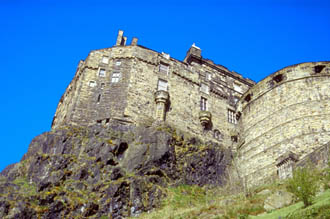 Edinburgh Castle is visited annually by approximately one million people - if we except the Tower of London that is more people than visit any other ancient monument in the United Kingdom. Every visitor - particularly those on a restricted itinerary - should visit the Castle, not only because of the historical interest of this remarkable fortress and former royal residence, but because it offers such splendid panoramic views of the city. It is from these battlements, for example, that the traveller immediately appreciates the dramatic topography of Edinburgh, situated between sea and hills.
Edinburgh Castle is visited annually by approximately one million people - if we except the Tower of London that is more people than visit any other ancient monument in the United Kingdom. Every visitor - particularly those on a restricted itinerary - should visit the Castle, not only because of the historical interest of this remarkable fortress and former royal residence, but because it offers such splendid panoramic views of the city. It is from these battlements, for example, that the traveller immediately appreciates the dramatic topography of Edinburgh, situated between sea and hills.
Within the confines of the Castle, there is much to see. It was the seat (and regular refuge) of Scottish Kings, and the historical apartments include the Great Hall, which now houses an interesting collection of weapons and armour.
The Royal apartments include a tiny room in which Mary, Queen of Scots gave birth to the boy who was to become King James VI of Scotland and James 1 of England upon the death of Queen Elizabeth in 1603. The ancient Honours of Scotland - the Crown, the Sceptre and the Sword of State - are on view in the Crown Room. Nearby is the Scottish National War Memorial, a building designed and created shortly after the First World War; many who enter find the experience a moving one.
Edinburgh Castle is also the home of the One O'Clock Gun. This is fired every day except Sunday at precisely 1.00pm to provide everyone with an accurate check for their clocks and watches. It will certainly startle you if you are anywhere near the Castle at that moment!
The Castle Esplanade is the venue of the world-famous Edinburgh Military Tattoo, the annual occasion on which, over a period of three weeks in August, the Army presents a lively programme of music, marching and historical re-enactments under floodlights before large and appreciative audiences.
The oldest building in all Edinburgh is to be found within the Castle precincts. It is St. Margaret's Chapel, a tiny Norman building which has been standing there intact for more than 900 years. It has survived all the sieges and bombardments to which the fortress on the rock was subjected during that period. On several occasions the castle was razed - but the demolishers invariably spared the chapel of the good St Margaret because of its religious significance. Today, members of the castle garrison still have the right to be married within the Chapel.
Before leaving the Esplanade, look in the north-east corner for a small iron wall-fountain; it is popularly known as the Witches' Well, and it commemorates the grim fact that, centuries ago, many women held to be guilty of witchcraft were put to death at the stake on this spot.
To the north, between the Castle and the Firth of Forth, the spectator has his first glimpse of Edinburgh's new town. To the east, below the Castle ramparts the visitor is recommended to take a close look at the Old Town.
點(diǎn)擊查看本頻道更多精彩內(nèi)容